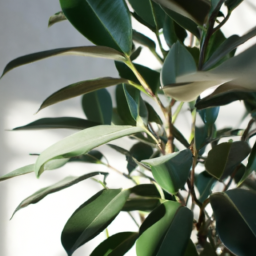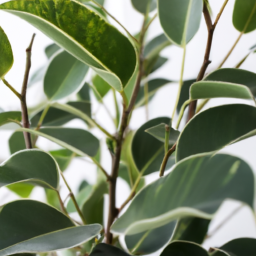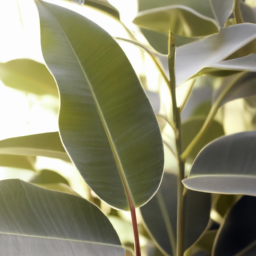
Are you looking to add a touch of greenery to your indoor space? If so, exploring the different types of ficus indoor plants might be just the solution you need. Ficus plants are known for their lush foliage and air-purifying properties, making them a popular choice for indoor plant enthusiasts. In this blog post, we will delve into the various types of ficus plants that thrive indoors, helping you choose the perfect one for your home or office. So, let’s dive in and discover the beauty and benefits of these versatile indoor plants!
Benefits of Growing Different Types of Ficus Indoors
Introduction
When it comes to indoor plants, ficus trees are a popular choice for many homeowners. Not only are they beautiful and easy to care for, but they also offer a variety of benefits for your indoor space. In this article, we will explore the different types of ficus trees that you can grow indoors and the unique benefits that each type offers.
Types of Ficus Trees
There are several different types of ficus trees that are well-suited for indoor growing. One of the most popular varieties is the Ficus lyrata, also known as the fiddle leaf fig. This tree features large, glossy leaves that add a touch of elegance to any room. Another common type is the Ficus benjamina, or weeping fig, which has delicate, drooping leaves that create a soft and graceful look.
Additionally, the Ficus elastica, or rubber tree, is a great option for indoor growing. This tree has thick, shiny leaves that can add a tropical feel to your space. The Ficus microcarpa, or Chinese banyan, is another popular choice, with its small, dark green leaves and twisting trunk that can create a unique focal point in any room.
Benefits of Growing Ficus Trees Indoors
1. Air Purification: Ficus trees are known for their air-purifying qualities, making them a great addition to any indoor space. These plants can help remove toxins from the air, such as formaldehyde and benzene, improving the overall air quality in your home.
2. Aesthetic Appeal: Ficus trees are not only beneficial for your health, but they also add a touch of beauty to your indoor space. With their lush green leaves and unique shapes, ficus trees can enhance the aesthetic of any room and create a calming and inviting atmosphere.
3. Low Maintenance: One of the best things about growing ficus trees indoors is that they are relatively low maintenance. These plants are drought-tolerant and can thrive in a variety of lighting conditions, making them ideal for busy homeowners or those with limited gardening experience.
In conclusion, growing different types of ficus trees indoors can offer a range of benefits, from air purification to aesthetic appeal. Consider adding a ficus tree to your indoor space to enjoy these advantages and create a healthier and more beautiful home environment.

Popular Varieties of Ficus for Indoor Spaces
Benjamina Ficus
Ficus benjamina, also known as the weeping fig, is one of the most popular varieties of ficus for indoor spaces. This plant has long, slender leaves that cascade down, giving it a graceful and elegant appearance. Benjamina ficus is relatively easy to care for, making it a great choice for beginners. It thrives in bright, indirect light and prefers to be kept away from drafts and sudden temperature changes. Water your benjamina ficus when the top inch of soil feels dry to the touch, and be sure to provide it with regular fertilization during the growing season.
One of the key benefits of the benjamina ficus is its air-purifying qualities. This plant can help remove toxins from the air, improving indoor air quality and creating a healthier living environment. In addition to its air-purifying properties, the benjamina ficus is also known for its resilience and adaptability. With proper care, this plant can live for many years and grow to be quite large, making it a striking focal point in any indoor space.
If you’re looking to add a touch of elegance and sophistication to your home or office, consider adding a benjamina ficus to your indoor plant collection. With its graceful appearance, easy care requirements, and air-purifying benefits, this plant is sure to bring beauty and health to your indoor space.
Elasctica Ficus
Ficus elastica, also known as the rubber plant, is another popular variety of ficus for indoor spaces. This plant is named for its thick, rubbery leaves that can range in color from dark green to variegated patterns. The elastica ficus is a low-maintenance plant that thrives in bright, indirect light and prefers to be watered when the top inch of soil feels dry. Like the benjamina ficus, the elastica ficus is known for its air-purifying qualities, making it a great choice for improving indoor air quality.
One of the unique features of the elastica ficus is its ability to grow quite tall, making it a striking statement plant for larger indoor spaces. With proper care and regular pruning, this plant can reach heights of up to 6 feet or more, adding a touch of drama and elegance to any room. The rubber plant is also known for its adaptability to different light conditions, making it a versatile choice for a variety of indoor environments.
If you’re looking for a low-maintenance plant that can add a touch of drama and elegance to your indoor space, consider adding a rubber plant to your collection. With its unique rubbery leaves, air-purifying qualities, and ability to grow tall and striking, the elastica ficus is sure to make a statement in your home or office.
Lyrata Ficus
Ficus lyrata, also known as the fiddle leaf fig, is a popular variety of ficus for indoor spaces that has gained popularity in recent years. This plant is named for its large, fiddle-shaped leaves that can grow up to 18 inches long, giving it a dramatic and sculptural appearance. The lyrata ficus thrives in bright, indirect light and prefers to be watered when the top inch of soil feels dry. This plant is known for its air-purifying qualities, making it a great choice for improving indoor air quality.
One of the key benefits of the lyrata ficus is its ability to add a touch of elegance and sophistication to any indoor space. With its large, glossy leaves and striking silhouette, this plant can serve as a focal point in any room. The fiddle leaf fig is also known for its resilience and adaptability, making it a great choice for both beginner and experienced plant enthusiasts.
If you’re looking to add a touch of drama and elegance to your indoor space, consider adding a fiddle leaf fig to your plant collection. With its large, fiddle-shaped leaves, air-purifying qualities, and ability to serve as a striking focal point, the lyrata ficus is sure to bring beauty and style to your home or office.

Care Tips for Different Types of Ficus Plants Grown Indoors
Choosing the Right Type of Ficus Plant for Your Indoor Space
When it comes to choosing the right type of ficus plant for your indoor space, there are a few factors to consider. One of the most important things to think about is the amount of light that your space receives. Some ficus plants, such as the Fiddle Leaf Fig, require bright, indirect light to thrive, while others, like the Weeping Fig, can tolerate lower light conditions.
Another factor to consider is the size of the plant. Some ficus plants can grow quite large, so it’s important to make sure that you have enough space for your chosen plant to reach its full potential. Additionally, you’ll want to consider the level of maintenance that you’re willing to commit to. Some ficus plants require more frequent watering and pruning than others.
Once you’ve considered these factors, you can choose the right type of ficus plant for your indoor space. Whether you opt for a Fiddle Leaf Fig, a Weeping Fig, or another variety, following these care tips will help your plant thrive.
General Care Tips for Ficus Plants Grown Indoors
Regardless of the specific type of ficus plant you choose, there are some general care tips that apply to all ficus plants grown indoors. One of the most important things to remember is to water your plant regularly, but be careful not to overwater. Ficus plants prefer to dry out slightly between waterings, so it’s best to let the top inch of soil dry out before watering again.
In addition to watering, ficus plants also benefit from regular fertilization. A balanced, water-soluble fertilizer can help provide the nutrients that your plant needs to thrive. Be sure to follow the instructions on the fertilizer package to avoid over-fertilizing, which can harm your plant.
Another important aspect of caring for ficus plants indoors is pruning. Regular pruning can help encourage new growth and keep your plant looking its best. Be sure to use sharp, clean scissors or pruning shears to avoid damaging the plant.
By following these general care tips, you can help ensure that your ficus plant stays healthy and happy in your indoor space.
Specific Care Tips for Different Types of Ficus Plants
In addition to the general care tips mentioned above, there are some specific care tips that apply to different types of ficus plants. For example, Fiddle Leaf Figs prefer bright, indirect light and well-draining soil. They also benefit from regular misting to increase humidity around the plant.
On the other hand, Weeping Figs can tolerate lower light conditions, but they prefer consistent moisture in the soil. Be sure to water your Weeping Fig regularly, but be careful not to let the soil become waterlogged.
Rubber Ficus plants are another popular choice for indoor spaces. These plants prefer bright, indirect light and well-draining soil. They also benefit from regular pruning to maintain their shape and encourage new growth.
By following these specific care tips for different types of ficus plants, you can help ensure that your plant thrives in your indoor space. Remember to monitor your plant regularly and adjust your care routine as needed to keep your ficus happy and healthy.
Let’s recap
Ficus plants are a popular choice for indoor houseplants due to their lush green foliage and easy care requirements. There are several different types of ficus plants that can thrive indoors, each with its own unique characteristics. One common type is the Ficus lyrata, also known as the fiddle leaf fig, which has large, violin-shaped leaves that make a bold statement in any room.
Another popular ficus variety is the Ficus benjamina, or weeping fig, which has delicate, drooping leaves that add a touch of elegance to indoor spaces. The Ficus elastica, or rubber plant, is another favorite choice with its thick, glossy leaves and low-maintenance nature. No matter which type of ficus plant you choose, they all have the potential to brighten up your home and bring a touch of nature indoors.
Let me leave you with some FAQs:
Q1: What are the different types of ficus plants that can be grown indoors?
A1: There are several popular types of ficus plants that thrive indoors, including Fiddle Leaf Fig, Rubber Plant, Weeping Fig, and Benjamina Fig.
Q2: Which type of ficus plant is best for beginners?
A2: The Rubber Plant is a great choice for beginners as it is easy to care for and can adapt to various indoor conditions.
Q3: How much light do indoor ficus plants need?
A3: Most ficus plants prefer bright, indirect light. They should be placed near a window where they can receive plenty of natural light without being exposed to direct sunlight.
Q4: What is the best way to water indoor ficus plants?
A4: Ficus plants prefer to have their soil kept consistently moist but not waterlogged. It’s important to allow the top inch of soil to dry out between waterings to prevent root rot.
Q5: How often should indoor ficus plants be fertilized?
A5: Indoor ficus plants should be fertilized every 4-6 weeks during the growing season (spring and summer) with a balanced liquid fertilizer diluted to half strength. Fertilizing should be reduced or stopped during the dormant winter months.
Dr. Olivia Green is a botanist with over two decades of experience in indoor plant cultivation. She holds a Ph.D. in Plant Biology and has dedicated her career to researching plant behavior in controlled environments. Dr. Green is passionate about helping plant enthusiasts master the art of indoor gardening through her extensive knowledge and practical insights.


